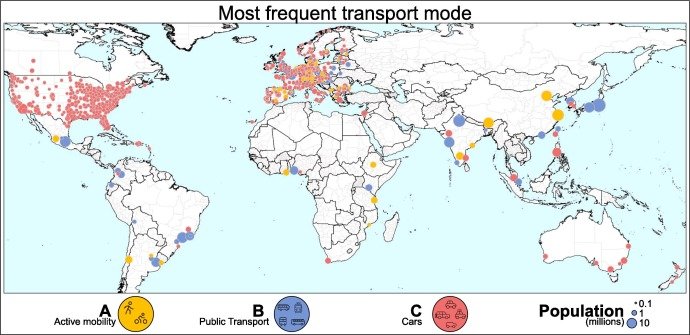size matters, but income rules: urban car dependence worldwide – science direct study

In a world grappling with the environmental and social costs of car-centric cities, understanding the drivers of transport mode choices has become increasingly crucial. A new study by Rafael Prieto-Curiel & Juan P. Ospina published on Science Direct offers fresh insights into this complex issue, analyzing data from nearly 800 cities across 61 countries to model the use of active mobility (walking, cycling), public transport, and private cars.
The findings paint a nuanced picture, highlighting how city characteristics like size, income levels, and regional contexts shape the modal share – the proportion of journeys made by different transport modes. By expressing each city’s modal split as an “ABC triplet,” the researchers uncovered some striking patterns.

Bigger Isn’t Always Better for Sustainable Mobility Contrary to common assumptions, the study reveals that larger cities tend to have lower rates of active mobility and private car use, but a more prominent role for public transport. This trend is likely driven by the longer distances and congestion experienced in major urban centres, making alternatives to private vehicles more attractive and necessary.
Income Fuels Car Dependence Perhaps unsurprisingly, the research confirms a strong positive relationship between a city’s income levels and its reliance on private cars. The results show that a city with twice the income has a staggering 37% more journeys made by private vehicles. This finding underscores the persistent challenges of promoting sustainable mobility in affluent urban areas, where car ownership and use remain deeply entrenched.

Regional Differences in Modal Choices One of the study’s most intriguing revelations lies in the stark regional disparities in transport mode preferences. Asian cities, for instance, stand out for their substantial reliance on public transport systems. In contrast, cities in the United States, Canada, Australia, and New Zealand exhibits a stubborn dependence on private cars, regardless of their size.
Europe, meanwhile, presents a diverse tapestry of modal choices. While some cities like Utrecht prioritize active mobility, others like Paris and London have established robust public transport networks as their mobility backbones. Yet, other European urban centres, such as Rome and Manchester, remain firmly entrenched in car-centric lifestyles, with more than two-thirds of journeys undertaken by private vehicles.
Addressing Car Dependence: A Multifaceted Challenge The study’s authors emphasize that reducing urban car dependence requires a nuanced understanding of the interplay between city characteristics, income levels, and regional factors. As cities worldwide grapple with the environmental, social, and economic costs of car-centric transportation systems, these findings underscore the need for tailored strategies that account for local contexts and drivers of modal choices.
With sustainable mobility emerging as a crucial priority for urban policymakers, studies like this one offer valuable insights to inform evidence-based interventions, from investing in public transport infrastructure to incentivizing active travel and implementing progressive policies to discourage private car use in cities.
As the global community strives to create more livable, equitable, and environmentally responsible urban spaces, unravelling the complex web of factors that shape our transport choices has become imperative. This latest research serves as a reminder that the path to sustainable mobility is a multifaceted challenge, but one that must be tackled with urgency and a deep understanding of the forces at play.
